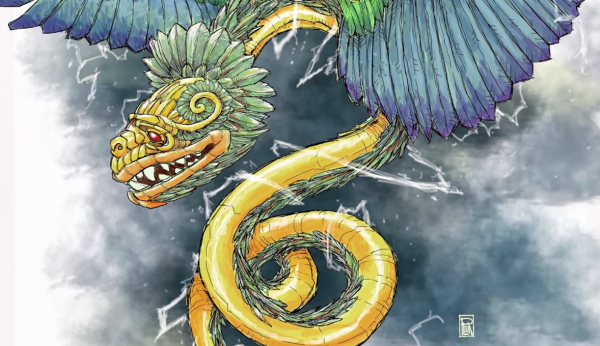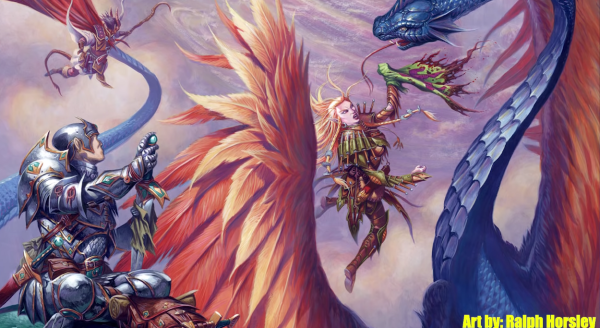So, you want to be a Summoner? A wielder of beings from other realms? Then you have come to the right place. Grab a seat and we will tell you what you can do in D&D 5e to make summoning creatures fun and satisfying.
The Quintessential Summoner Classes
There are three subclasses that encapsulate the essentials of summoning. We will speak about each in detail.
Conjuration Wizard
It’s in the name really. A wizard in the School of Conjuration has the best abilities to buff up your summoned creatures.
Calling creatures from various realms of existence to come and aid you in battle is immensely powerful, both in-game mechanics as well as in flavour. Creating bonds with these conjured creatures also forges memorable bonds between your party members.
Your power in summoning creatures really comes to fruition in the mid-level ranges.
- At Level 10, you gain Focused Conjuration that ensures that your summoned creatures cannot be destroyed or unbound from you by breaking your concentration. This means your creatures will potentially last for more rounds and not turn on your party to attack you (which can be a huge problem for many of the “Conjure X” spells).
- At Level 14, you gain one of the most powerful features for summoned creatures, Durable Summons. An extra 30 temporary HP for your summoned creatures is excellent to soak damage and to last longer. I’ve seen this in action and the wizard’s elementals came in clutch in almost every encounter.
A bonus with this build is your plethora of teleportation abilities. When you summon your creature, you are left with non-concentration spells. You could really lean into conjuration and become the hand that shapes the battle.
With Benign Transportation, Misty Step, Thunder Step, and Dimension Door, you can bring a friend around the battlefield to where they are needed most. Imagine you are able to control a battle like a chess prodigy – immaculate.

Necromancy Wizard
Obviously, necromancy is an option. They can create servants of the dead in an instant and doing so offers great benefits to those creatures. This is not for the faint of heart and it can be limiting in flavour.
Very fun build
Death is not always what we want our characters to be steeped in. But they offer fun builds and, if you think outside of the box, very unique characters.
Your power over death begins to manifest at Level 6. With Undead Thralls, you are able to make more dead creatures with your Animate Dead spell, as well as buff them up in both health and to hit.
Many options
Now, this offers you a little bit more power in your summons earlier than the Conjuration Wizard, but this ability only affects the Animate Dead spell. A little less versatility in flavour and options, but you could also access this earlier. It really depends on what you are looking for.
There are no other specific subclass features that affect your ability to summon. However, overall, Necromancer Wizards are excellent choices for summoning as their spell list offers additional synergies to just summoning. We will run through more of these spells in a later section.
Circle of the Shepard Druid
We now move from the arcane to the natural magic that flows through the world. Druids are an exceedingly versatile class but do have a lot of abilities to handle. If you are newer to the game and do not want to get lost in the weeds, perhaps try one of the Wizard subclasses. But if you are not faint of heart or are looking to try out my favourite class in the game, then perhaps the Circle of the Shepard Druid is for you.
The idea of this druid is that they connect with the spirits of nature and in doing so these spirits can manifest themselves for the druid to help in the role the druid has chosen for themself. The spirits of the wilderness walk with them.
Level 6 Mighty Summoner
This summoning comes into play at Level 6 when you gain Mighty Summoner. With this druid, you will only have access to certain summoning spells and this particular feature only targets beasts and fey summoned.
But the additional hit points and adding the ‘magical’ tag for their weapon attacks is a game changer. When you start to fight higher-level enemies, not having to worry about if an attack from a conjured creature will be halved is very relieving.
Level 14 Faithful Summon
Also at Level 14, you gain the Faithful Summons feature. This feature is a feel-good, wonderful addition to the subclass and can come in clutch if you are incapacitated.
Conjure Animals will immediately be cast when you are reduced to 0HP, or you are incapacitated. The beasts will come to your aid and protect your body for a full hour unless you are brought back up and dismiss them. This feature really ties into the idea that your druid has gained the favour of the spirits of nature.
You are their champion and that feeling can really be crystallized if this feature comes up. The downside is that this feature may not come up that often – to some this does not compare to the Durable Summons feature of the Conjuration Wizard. It really depends on what you value.

The Less Popular (But Still Fun!) Summoning Classes
Now that we’ve talked about the Big Three, we can talk about some classes that have the traits of summoning that are still quite fun but not what you would normally think of when imagining a conjurer.
These two subclasses I will mention focus on only one summoned creature: your familiar, whether through the Find Familiar spell or through the subclass itself.
Circle of Wildfire Druid
While fire is not what you think about as a natural part of life, these druids know that destruction is a part of creation. Cleansing the earth is just as vital to prolonging life as water is.
The Summoning of the Wildfire Spirit
This manifests as a Wildfire Spirit that becomes your summoned companion at Level 2 with the Summon Wildfire Spirit feature. This Wildfire Spirit has its own stat block and can do any range of actions on its turn, including throwing a Flame Seed at enemies and teleporting itself and anyone within 5 feet of it, 15 feet across the battlefield. This Spirit can manifest as any shape or creature as long as it is in the Small size category.
Your bond with this Wildfire Spirit gets greater as you level up. The Spirit does not gain any more abilities or health like in other summoning subclasses, but it does enhance the spells that either heal or deal fire damage (Enhanced Bond at Level 6). At Level 14, you gain Blazing Revival which gives you a second chance at life by reducing your Spirit to 0HP instead of you. Then you regain half of your HP.
The Growing Bond with the Wildfire Spirit
If you focus your energy on creating moves with your Wildfire Spirit in combat (as well as outside of combat), the possibilities are quite explosive. I’ve seen one of these druids march into battle to cast a devastating spell in range, only to then be immediately whisked to safety by their Wildfire Spirit.

Pact of the Chain Warlock
Many take the Pact of the Chain boon when building their warlock for flavour. Having a familiar as a pseudodragon or quasit is very fun and allows ridiculous and beautiful scenes to unfold. (A warlock in one of my campaigns had a quasit named Phil who had a beautiful New York accent and loved hot dogs). Each of the additional familiar forms has a bonus ability that the regular familiars don’t.
Eldritch invocation
In particular, the imp’s ability to become invisible and the quasit’s ability to transform at will into four other creatures are excellent for scouting and other shenanigans. However, I would like to focus on the ability that allows this familiar to attack with its reaction when you take the Attack action.
I would suggest taking the Eldritch Invocation: Investment of the Chain Master. Your familiar gains so many benefits to this:
- They gain a flying or swimming speed of 40 feet;
- They can make an attack on your bonus action;
- Their weapon attacks are considered magical;
- Their saving throws use your spell save DC; and
- You can use your reaction to grant it resistance to damage it is taking.
Other invocations
There are other Invocations that affect your familiar (Gift of the Ever-Living Ones and Voice of the Chain Master) but they do not offer the breadth that Investment of the Chain Master does. With all of that, your familiar can attack twice on your turn and be an excellent scout. However, I would recommend using your Action for casting a spell or doing any number of other actions, while using your bonus action to attack with your familiar.
None of the patrons offer anything in particular to buff up your familiar or the interactions with your familiar, so I would choose a patron that speaks to you (because they speak to you!).
Must-Have Spells for a Summoner Build
With classes and subclasses out of the way, we can move on to spells. It’s not hard to say that having either the ‘Summon X’ spell or ‘Conjure X’ spell is extremely important. For reference these are all of the Summon and Conjure spells in D&D 5e:
- Conjure Animals (3rd)
- Conjure Celestial (7th)
- Conjure Elemental (5th)
- Conjure Fey (6th)
- Conjure Minor Elemental (4th)
- Conjure Woodland Beings (4th)
- Summon Aberration (4th)
- Summon Beast (2nd)
- Summon Celestial (5th)
- Summon Construct (4th)
- Summon Draconic Spirit (5th)
- Summon Elemental (4th)
- Summon Fey (3rd)
- Summon Fiend (6th)
- Summon Greater Demon (4th)
- Summon Lesser Demon (3rd)
- Summon Shadowspawn (3rd)
- Summon Undead (3rd)
Honorary members of this list:
- Find Familiar (1st)
- Animate Dead (3rd)
Prepare your summon spells
In general, the Summon spells are useful to be prepared because they take one Action to cast as opposed to the 1 Minute Casting Time of most Conjure spells (Conjure Animals and Conjure Woodland Beings are the exceptions).
However, when you know you are going into a combat or a high-stress area like a dungeon, casting a Conjure spell and having your bigger, beefier summoned creature with you is better overall (if you have access to Conjure Elemental and you are unsure if the space is going to be big, an Air Elemental is a great option in my experience).
Druid
As a Druid, Conjure Animals is one of my favourite spells. Having the ability to have a few wolves or a couple of bears really adds some excellent distractions from your fellow party members. Plus, it really feeds into the flavour of having nature come to your aid.
Wizard
For a Wizard, Conjure Elemental and Summon Elemental are great options. They provide versatility as you can choose between a few different options – mostly Air, Earth, Fire, and Water. Each has their own benefits.
Air Elementals can fit into tight spaces and have a 90 ft. fly speed. Earth Elementals can burrow underground and have a lot of HP. Water Elementals have a 90 ft. swim speed and have an attack that allows for multiple creatures to be grappled. I find Fire Elementals the least powerful of the elementals and I do not see them come out often as they also light everything on fire.
Avoid concentration spells
In addition to these spells, I would recommend anything that does not require concentration as a blanket statement. For the Conjure spells, if you lose concentration, the summoned creature does not go away – instead they become hostile to you and your friend, and it may attack you.
So, losing concentration is a scenario that you do not want to come to fruition (the exceptions here are Conjure Animals and Conjure Woodland Beings). I would suggest a good mix of damage dealing and utility spells, as often the utility spells can be used on your elementals as well.
Buff elementals
Having spells that buff your elementals are options for you to have. There is always the option to buff your allies but if you have an extra slot, these are handy to have.
- Haste (3rd, Wizard) – Allows your summoned creature to have doubled speed, +2 AC, advantage on Dex saves, and an additional action on its turn.
- Enlarge/Reduce (2nd, Wizard) – If Enlarge is chosen, the summoned creature gets advantage on Str checks and saves as well as an extra 1d4 damage.
- Beast Bond (1st, Druid) – Allows you to connect telepathically with your summoned beasts which could help with any scouting or other out-of-combat scenario.
Closing Thoughts on summoner builds
Conjuring creatures is such a powerful thing to do in D&D. It feels so out-of-this-world and brings you right into your character’s perspective. You have this creature with you that can act beyond your capability.
More versatility
It’s incredible and it offers such versatility in what you can do during combat. You have your turn, and you have your summoned creature’s turn(s). If you need to be available to turn a knob or decipher a text mid-combat, your summoned creature can still support your party.
I have had a Conjuration Wizard in one of my games before and the bonds that the characters made with the elementals that he conjured were so wonderful. I flavoured that they were the same elementals answering his calls every time. Wendy, Flameo Hotman, Dwayne, and Caspian were a part of the adventuring party.
A lot of different builds
There are some very different feeling summoners available in D&D. You can focus on one familiar or summon hordes or powerful beings from other worlds. It is not always easy having an additional (or many) creature to control but as long as you are aware of the tides of battle, you can change them quite quickly.
I would also say, try out the different Conjure/Summon spells and check out the associated stat blocks. It might help you decide what kinds of creatures make the most sense for the character you are building. There is no harm in trying out the spells in combat (and out of combat too!).
Have fun!
